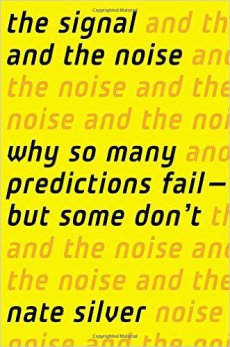
Silver, N. (2012). The Signal and the Noise: Why So Many Predictions Fail – But Some Don’t. New York: The Penguin Press.
In my memory Nate Silver has been in the news quite often since the 2008 election. I first learned about him due to his FiveThirtyEight.com Blog and accurate forecasts of the election. As an Analyst who frequently works with forecasting and ironing out prediction model, this book was right up my alley. Being as he is a highly respected Statistician, I wanted to get his take on analysis and perhaps how I could utilize his insight in my own work.
One of the areas of discussion I related to highly was that “we should not expect machines to do our thinking for us” (Silver, 2012, p.264). In all of the interviews I have ever done in my Analytics career, they have all shared the common question of “How creative are you?” While the field of Analytics appears to be a just an area of statistics and logic, this is not the case. As Nate Silver (2012) states, “computers are not very good at tasks that require creativity and imagination, like devising strategies or developing theories” (p.289). As someone who digs in to the data and interprets actionable insights, I could not agree more. He also argues early in the book that pure objectivity is not possible in the world (Silver, 2012, p. 72). Rather, statistical models and language are both “approximations about the universe” (Silver, 2012, p. 230).
As a means to combat this, the Bayes’s Theorem is introduced for the second half of the book. Nate Silver (2012) says, “it tells us the probability that a theory or hypothesis is true if some event has happened” (p.243). He concludes that forecasting should be done looking in terms of percentages and probabilities (Silver, 2012, p. 404). His diagrams and examples have given me some practical insight in how to better optimize my own forecasting models.
One of my only criticisms of the book was how the structure was split into two parts, without it being clearly defined. There is a sentence early in the introduction chapter explaining there are two parts of the book, but it would be easy to miss for the reader that is not scrupulously taking notes. I wish the book had clearly split out the chapters with a Part 1 and Part 2, to make it easier for the reader.
Even at just 5 years since the publishing date, it dawned on me how even this book was slightly dated in that it pointed to a forecast of Donald Trump being elected as president being inaccurate (Silver, 2012, p. 55). The forecaster was incorrect as to the year he would be successful in his presidential run, but not in the reasoning behind it. That can now be said looking at the most recent election cycle. I would be curious to see an updated version of this book later in the decade, or early on in the next. With the political pendulum swinging from the left to the right in the middle of this decade and the global movement of populism and increasing aging populations, I would be fascinated to read in retrospect about what forecasts hit the mark.
Advertisements Share this:- More






